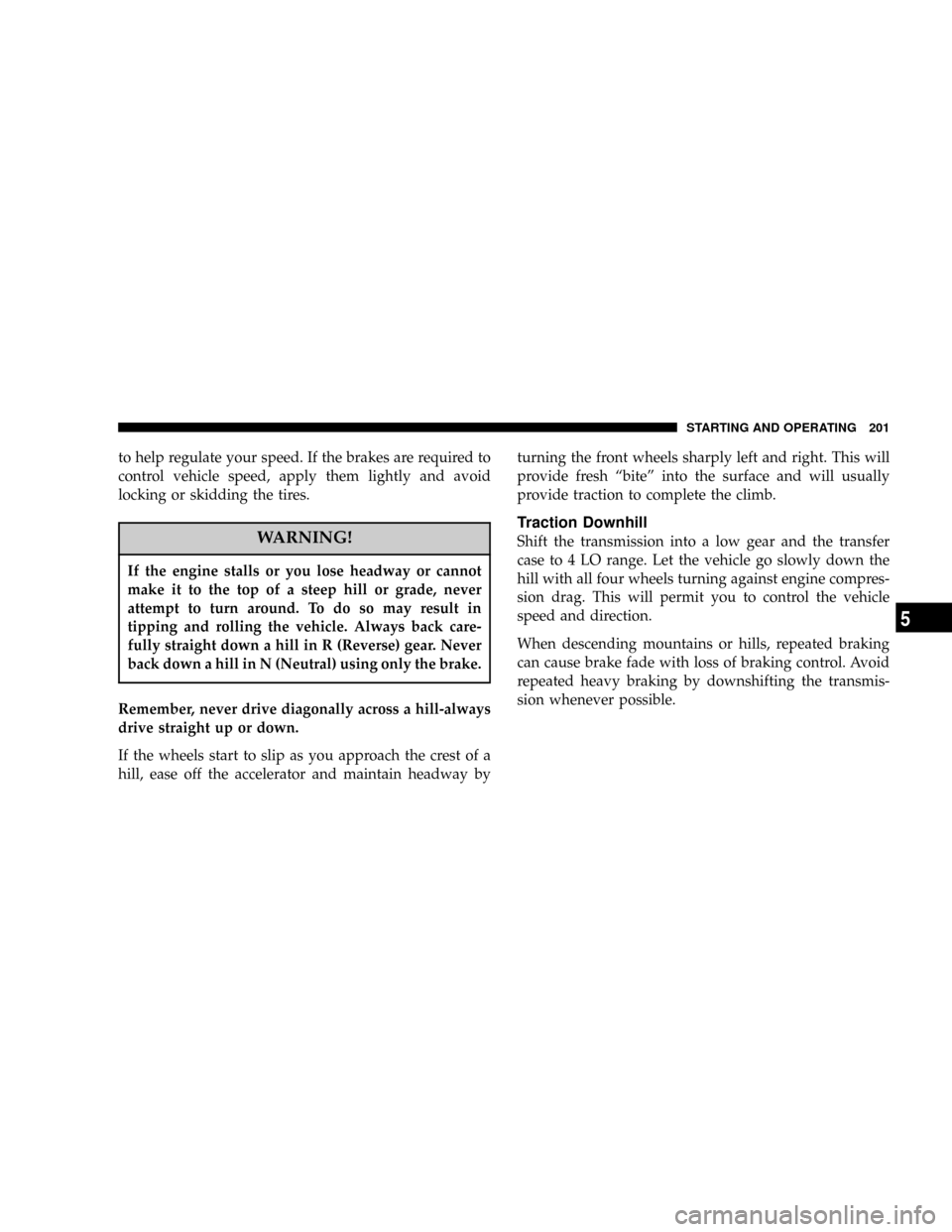brake light JEEP GRAND CHEROKEE 2004 WK / 3.G Owners Manual
[x] Cancel search | Manufacturer: JEEP, Model Year: 2004, Model line: GRAND CHEROKEE, Model: JEEP GRAND CHEROKEE 2004 WK / 3.GPages: 344, PDF Size: 6.09 MB
Page 78 of 344

to turn this feature on or off. Also, refer to ªWindshield
Wipers and Washersº in this section for more information
NOTE:When your headlights come on during the
daytime, the instrument panel lights will automatically
dim to the lower nighttime intensity. Refer to ªInstru-
ment Panel and Interior Lightsº below for setting the
instrument panel lights to full daytime intensity.
Instrument Panel and Interior Lights
When the multi-function control lever is in the parklight,
headlights, or AUTO position (if equipped), rotating the
center portion of the lever up and down will increase and
decrease the brightness (dimmer control) of the instru-
ment panel lights. Full daytime brightness on all elec-
tronic displays (odometer, overhead console, radio, and
Automatic Climate Control (if equipped) is obtained by
rotating the center portion of the control to the first
detent above the dimmer range. Rotating the control to
the second detent above the dimmer range turns theinterior lights on. Rotating the control to the ªOffº
(extreme bottom) position disables all the interior lights,
even when the doors and liftgate are open. While in the
ªOffº position the instrument panel lighting is at the
lowest light level and may not be suitable for night
driving.
Daytime Running Lights Ð Canada Only
The headlights come on at a low intensity level whenever
the engine is running. The lights remain on until the
ignition switch is turned OFF or the parking brake is
engaged. The headlight switch must be used for normal
night time driving.
Lights-On Reminder
If the headlights or parking lights are on after the ignition
is turned OFF, a chime will sound when the driver's door
is opened.
78 UNDERSTANDING THE FEATURES OF YOUR VEHICLE
Page 86 of 344

ELECTRONIC SPEED CONTROL
When engaged, this device takes over accelerator opera-
tions at speeds greater than 40 mph (60 km/h). The
controls are mounted on the steering wheel and consist of
ON´OFF, SET, RES´ACCEL, CANCEL, and COAST con-
trols.
To Activate
Press the ON´OFF button to turn the system ON. To turn
the system OFF, press the ON´OFF button again. The
system should be turned OFF when not in use. The
CRUISE indicator light in the instrument cluster will
illuminate when the system is ON.
To Set at a Desired Speed
When the vehicle has reached the desired speed, press
and release the SET button. Release the accelerator and
the vehicle will operate at the selected speed.
To Deactivate
A soft tap on the brake pedal, normal braking, or pressing
the CANCEL button will deactivate the Speed Control
without erasing the memory. Pressing the ON´OFF to
turn the system OFF or turning off the ignition erases the
memory.
86 UNDERSTANDING THE FEATURES OF YOUR VEHICLE
Page 133 of 344

18. Seat Belt Indicator Light
When the ignition switch is first turned ON, this
light will turn on for 5 to 8 seconds as a bulb check.
During the bulb check, if the driver's seat belt is
unbuckled, a chime will sound. After the bulb check or
when driving, if the driver seat belt remains unbuckled,
the Seat Belt Warning Light will flash or remain on
continuously. Refer to9Enhanced Driver Seat Belt Re-
minder System (BeltAlertŸ)9in the Occupant Restraints
section for more information.
19. Anti-Lock Warning Light
The amber ABS warning light will come on when
the ignition is first turned on, and stay on briefly
as a bulb check. If the bulb does not come on during
starting, have the bulb repaired promptly. This light also
illuminates to indicate that the Antilock Brake System
self-check is in process at vehicle start-up.If the light remains on after start-up, or comes on and
stays on at road speeds, it may indicate that the ABS has
detected a malfunction or has become inoperative. In this
case, the system reverts to standard non-antilock brakes.
Turn the engine off and on again to reset the Antilock
Brake System. If the light remains on, see your autho-
rized dealer. If both the red BRAKE and amber ABS
warning lights are on, see your authorized dealer imme-
diately.
20. Fuel Gage
The pointer shows the level of fuel in the fuel tank when
the ignition key is in the ON position. A small arrow
indicates the side of the vehicle where the filler cap (gas
cap) is located.
UNDERSTANDING YOUR INSTRUMENT PANEL 133
4
Page 134 of 344

21. Low Fuel Warning Light
When the fuel level reaches approximately 1.5 U.S.
Gallons (6L) this light will come on and remain on
until fuel is added. The ªLow Fuel Warning Lightº
may turn on and off again, especially during and after
hard braking, accelerations, or turns. This occurs due to
the shifting of the fuel in the tank.
Your vehicle has a programmable electronic feature that
will sound a chime when the ªLow Fuel Warning Lightº
comes on. See the information on ªOverhead Console Ð
Customer Programmable Featuresº in Section 3 to turn
this feature on.
22. Fog Light Indicator Light
This light shows when the fog lamps are on.23. Brake Warning Light
The red BRAKE warning light will come on when
the ignition is first turned on, and stay on briefly
as a bulb check. If the bulb does not come on
during starting, have the bulb repaired promptly. If the
light stays on longer, it may be an indication that the
parking brake has not been released.
If the light remains on when the parking brake is off, it
indicates a possible brake hydraulic system malfunction
or low fluid level. In this case, the light will remain on
until the cause is corrected. If a brake malfunction is
indicated, immediate repair is necessary and continued
operation of the vehicle in this condition is dangerous.
134 UNDERSTANDING YOUR INSTRUMENT PANEL
Page 194 of 344

Quadra-DriveTSystem Ð If Equipped
The optional Quadra-DrivetSystem features three
torque transfer couplings. The couplings include Vari-
Lok front and rear axles and Quadra-Trac IIttransfer
case. The optional Vari-Lok axles are fully automatic and
require no driver input to operate. Under normal driving
conditions the units function as standard axles balancing
torque evenly between left and right wheels. With a
traction difference between left and right wheels the
coupling will sense a speed difference. As one wheel
begins to spin faster than the other, torque will automati-
cally transfer from the wheel that has less traction to the
wheel that has traction. While the transfer case and axle
couplings differ in design, their operation is similar.
Follow the Quadra-Trac IIttransfer case shifting infor-
mation, preceding this section, for shifting this system.
VARI-LOK FRONT AND REAR AXLES Ð IF
EQUIPPED
The optional Vari-Lok axle is fully automatic and requires
no driver input to operate. Under normal driving condi-
tions the unit functions as a standard axle balancing
torque evenly between left and right wheels. With a
traction difference between left and right wheels the
coupling will sense a speed difference. As one wheel
begins to spin faster than the other, torque will automati-
cally transfer from the wheel that has less traction to the
wheel that has traction.
PARKING BRAKE
To set the parking brake, pull the lever up as firmly as
possible. When the parking brake is applied with the
ignition ON, the ªBrake Warning Lightº in the instru-
ment cluster will light.
194 STARTING AND OPERATING
Page 195 of 344

NOTE:The instrument cluster ªBrake Warning Lightº
indicates only that the parking brake is applied. It does
not indicate the degree of brake application.Before leaving the vehicle parked on a hill, you must
make sure the parking brake is fully applied and place
the gear selector in the P (Park) position. Make certain the
transfer case is in gear. Failure to do so may cause the
vehicle to roll and cause damage or injury.
When parking on a hill, it is important to set the parking
brake before placing the gear selector in P (Park), other-
wise the load on the transmission locking mechanism
may make it difficult to move the selector out of P (Park).
The parking brake should always be applied when the
driver is not in the vehicle.
STARTING AND OPERATING 195
5
Page 196 of 344

WARNING!
²Leaving children unattended in a vehicle is dan-
gerous for a number of reasons. A child or others
could be injured. Children should be warned not
to touch the parking brake or the gear selector
lever. Don't leave the keys in the ignition. A child
could operate power windows, other controls, or
move the vehicle.
²Do not leave children or animals inside parked
vehicles in hot weather. Interior heat build up
may cause serious injury or death.
To release the parking brake, pull up slightly, press the
center button, then lower the lever completely.Be sure the parking brake is fully disengaged before
driving. Failure to do so can lead to brake failure.
NOTE:Parking brake adjustment and maintenance
should be performed by your authorized dealer.
196 STARTING AND OPERATING
Page 197 of 344

ANTI-LOCK BRAKE SYSTEM
The Anti-Lock Brake System (ABS) is designed to aid the
driver in maintaining vehicle control under adverse
braking conditions. The system operates with a separate
computer to modulate hydraulic pressure to prevent
wheel lock-up and help avoid skidding on slippery
surfaces.
All vehicle wheels and tires must be the same size and
type and tires must be properly inflated to produce
accurate signals for the computer.
WARNING!
Significant over or under inflation of tires, or mixing
sizes of tires or wheels on the vehicle can lead to loss
of braking effectiveness.
The Anti-Lock Brake System conducts a low-speed self-
test at about 12 mph (20 km/h). If you have your foot
lightly on the brake while this test is occurring you may
feel slight pedal movement. The movement can be more
apparent on ice and snow. This is normal.
The Anti-Lock Brake System pump motor runs during
the self-test at 12 mph (20 km/h) and during an ABS stop.
The pump motor makes a low humming noise during
operation, which is normal.
WARNING!
Pumping of the Anti-Lock Brakes will diminish
their effectiveness and may lead to an accident.
Pumping makes the stopping distance longer. Just
press firmly on your brake pedal when you need to
slow down or stop.
STARTING AND OPERATING 197
5
Page 201 of 344

to help regulate your speed. If the brakes are required to
control vehicle speed, apply them lightly and avoid
locking or skidding the tires.
WARNING!
If the engine stalls or you lose headway or cannot
make it to the top of a steep hill or grade, never
attempt to turn around. To do so may result in
tipping and rolling the vehicle. Always back care-
fully straight down a hill in R (Reverse) gear. Never
back down a hill in N (Neutral) using only the brake.
Remember, never drive diagonally across a hill-always
drive straight up or down.
If the wheels start to slip as you approach the crest of a
hill, ease off the accelerator and maintain headway byturning the front wheels sharply left and right. This will
provide fresh ªbiteº into the surface and will usually
provide traction to complete the climb.
Traction Downhill
Shift the transmission into a low gear and the transfer
case to 4 LO range. Let the vehicle go slowly down the
hill with all four wheels turning against engine compres-
sion drag. This will permit you to control the vehicle
speed and direction.
When descending mountains or hills, repeated braking
can cause brake fade with loss of braking control. Avoid
repeated heavy braking by downshifting the transmis-
sion whenever possible.
STARTING AND OPERATING 201
5
Page 226 of 344

TRAILER TOWING
In this section you will find information on limits to the
type of towing you can reasonably do with your vehicle.
And you will find safety tips. Before towing a trailer
carefully review this information to tow your load as
efficiently and safely as possible.
The factory-installed Class III and Class IV Trailer Tow
Packages include a frame mounted receptacle and the
above required equipment. They also include some nec-
essary provisions for connecting an aftermarket electric
brake controller. It is a light blue wire, identified with a
tag, located under the instrument panel behind the brake
pedal. Other equipment, such as trailer sway controls
and braking equipment, trailer equalizing (leveling)
equipment and low profile mirrors, may also be required
or strongly recommended.To maintain warranty coverage, follow the requirements
and recommendations in this manual concerning ve-
hicles used for trailer towing.
Perform maintenance services as prescribed in the appro-
priate ªMaintenance Schedule.º Refer to Section 8 of this
manual. When your vehicle is used for trailer towing,
never exceed the gross axle weight rating (GAWR) by the
addition of:
²The tongue weight of the trailer.
²The weight of any other type of cargo or equipment
put in or on your vehicle.
226 STARTING AND OPERATING